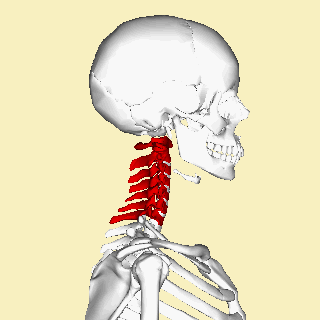Canadian C-Spine Rule: Difference between revisions
No edit summary |
No edit summary |
||
| Line 1: | Line 1: | ||
<div class="editorbox"> | <div class="editorbox"> | ||
'''Original Editor '''- [[User:Josh McCormack |Josh McCormack ]] | '''Original Editor '''- [[User:Josh McCormack|Josh McCormack ]] | ||
'''Lead Editors''' - Your name will be added here if you are a lead editor on this page. [[Physiopedia:Editors|Read more.]] | '''Lead Editors''' - Your name will be added here if you are a lead editor on this page. [[Physiopedia:Editors|Read more.]] | ||
| Line 12: | Line 12: | ||
The Canadian C-Spine Rule (CCR) is a decision making tool used to determine when radiography should be utilized in patients following trauma. <br> | The Canadian C-Spine Rule (CCR) is a decision making tool used to determine when radiography should be utilized in patients following trauma. <br> | ||
<br> | <br> | ||
== Population == | == Population == | ||
| Line 22: | Line 22: | ||
<br> | <br> | ||
<br> | <br> | ||
== The Rule == | == The Rule == | ||
| Line 32: | Line 32: | ||
Dangerous mechanism: fall from 3 feet or 5 stairs, an axial load to the head, high speed MVA (>100km/h; 62/mph) or with rollover or ejection, a collision involving a motorized recreational vehicle, a collision involving a bicycle. | Dangerous mechanism: fall from 3 feet or 5 stairs, an axial load to the head, high speed MVA (>100km/h; 62/mph) or with rollover or ejection, a collision involving a motorized recreational vehicle, a collision involving a bicycle. | ||
A simple rear-end collision exludes: being pushed into oncoming traffic, being hit by a bus or large truck, a rollover, being hit by a high speed vehicle. | A simple rear-end collision exludes: being pushed into oncoming traffic, being hit by a bus or large truck, a rollover, being hit by a high speed vehicle. | ||
== Usefulness == | == Usefulness == | ||
[[ | [[Test Diagnostics|Sn]]= 99.4 [[Test Diagnostics|Sp]]=45.1 <ref name="Stiell et al.">Stiell IG et al. The Candian C-Spine Rule versus the NEXUS Low-Risk Criteria in patients with trauma. N Engl J Med 2003;349:2510-8.</ref> | ||
[[Test Diagnostics|Negative Likelihood Ratio]] associated with this highly sensitive test is less than 5%. This means there is only a 5% chance that if you get a negative finding for this test, the patient would still have the condition. | |||
== Recent Related Research (from [http://www.ncbi.nlm.nih.gov/pubmed/ Pubmed]) == | == Recent Related Research (from [http://www.ncbi.nlm.nih.gov/pubmed/ Pubmed]) == | ||
<div class="researchbox"> | <div class="researchbox"> | ||
<rss>http://www.ncbi.nlm.nih.gov/entrez/eutils/erss.cgi?rss_guid=1xUFNDUH9GgdD9fTQh3jmskzwhBI3kW8ioWbzoYo6vxONHeQGE|charset=UTF-8|short|max=10</rss> | <rss>http://www.ncbi.nlm.nih.gov/entrez/eutils/erss.cgi?rss_guid=1xUFNDUH9GgdD9fTQh3jmskzwhBI3kW8ioWbzoYo6vxONHeQGE|charset=UTF-8|short|max=10</rss> | ||
</div> | </div> | ||
== References == | == References == | ||
<references /><br> | <references /><br> | ||
[[Category:Articles]] [[Category:Assessment]] [[Category:Cervical]] [[Category:EIM_Residency_Project]] [[Category:Extended_Scope]] [[Category:Musculoskeletal/Orthopaedics]] [[Category:Neurology]] [[Category:Special_Tests]] | [[Category:Articles]] [[Category:Assessment]] [[Category:Cervical]] [[Category:EIM_Residency_Project]] [[Category:Extended_Scope]] [[Category:Musculoskeletal/Orthopaedics]] [[Category:Neurology]] [[Category:Special_Tests]] | ||
Revision as of 09:55, 16 April 2013
Original Editor - Josh McCormack
Lead Editors - Your name will be added here if you are a lead editor on this page. Read more.
Purpose
[edit | edit source]
The Canadian C-Spine Rule (CCR) is a decision making tool used to determine when radiography should be utilized in patients following trauma.
Population[edit | edit source]
The Canadian C-Spine Rule is applicable to patients who are in an alert (Glasgow Coma Scale score of 15) and stable condition following trauma .
It is not applicable in non-trauma cases, if the patient has unstable vital signs, acute paralysis, known vertebral disease or previous history of Cervical Spine surgery and age <16 years.
The Rule[edit | edit source]
File:CCR.jpg[edit | edit source]
Important Definitions [edit | edit source]
Dangerous mechanism: fall from 3 feet or 5 stairs, an axial load to the head, high speed MVA (>100km/h; 62/mph) or with rollover or ejection, a collision involving a motorized recreational vehicle, a collision involving a bicycle.
A simple rear-end collision exludes: being pushed into oncoming traffic, being hit by a bus or large truck, a rollover, being hit by a high speed vehicle.
Usefulness[edit | edit source]
Negative Likelihood Ratio associated with this highly sensitive test is less than 5%. This means there is only a 5% chance that if you get a negative finding for this test, the patient would still have the condition.
Recent Related Research (from Pubmed)[edit | edit source]
Failed to load RSS feed from http://www.ncbi.nlm.nih.gov/entrez/eutils/erss.cgi?rss_guid=1xUFNDUH9GgdD9fTQh3jmskzwhBI3kW8ioWbzoYo6vxONHeQGE|charset=UTF-8|short|max=10: Error parsing XML for RSS
References[edit | edit source]
- ↑ Stiell IG et al. The Candian C-Spine Rule versus the NEXUS Low-Risk Criteria in patients with trauma. N Engl J Med 2003;349:2510-8.







